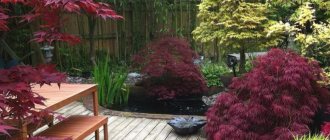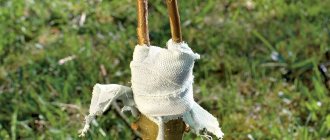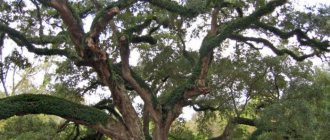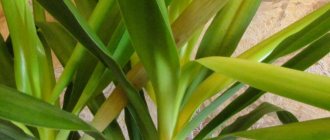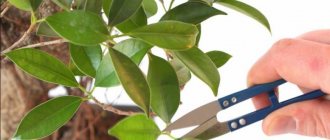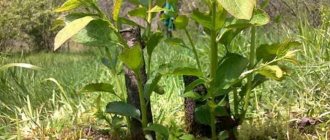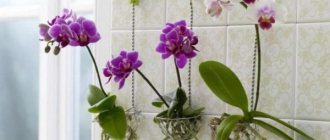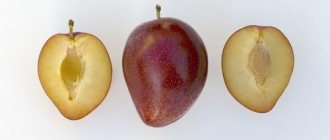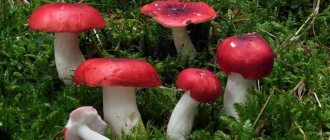You can only grow one type of coffee at home: Arabian. A plant of this species has wavy, smooth oval leaves with a sharp tip.
For a young tree you need to choose the right permanent location. The plant does not like unnecessary movements - even a slight change in its position in space will cause the leaves of the coffee tree to fall off.
The coffee tree needs a very bright place, but not direct sunlight. In partial shade, the plant will hurt and look pitiful. Irrigation and water quality are important. This plant does not like drying out or waterlogging the earthen clod. The soil must be selected very carefully: use peat or coconut substrate and regularly feed it with fertilizer that does not contain calcium salts. Leaves can dry out from lack of light and humidity, as well as from drafts. For good care, the coffee tree will thank you with real Arabian coffee beans!
Calculate the exact cost of repairs using an online calculator
and receive a free detailed estimate for repairs
Calculate Photo: sovetnews.com
Lemon Tree
These houseplants can be grown from seeds or cuttings. Fill a pot about 8cm in diameter with good soil and plant a few seeds so there is enough space around them. Water them generously and cover them with a plastic bag to retain moisture. Place the pot in a warm place. Once the seeds have germinated, remove the bag and place the plants in a bright place, but not in direct sunlight. If you decide to grow citrus fruits from cuttings, root them first. Then place in pots with peat mixed with sand.
The plant should be watered moderately. During fruit ripening, a drier substrate is needed. The optimal temperature for growing is from 20 to 30 degrees. Lemon trees are very sensitive to cold.
Only replant citrus fruits once they have filled the pot with roots. Take a slightly larger pot and do not fertilize immediately after transplanting, wait until the plant takes root in the new conditions. And place it in your office - it will immediately become more comfortable.
Photo: napalete.sk
Photo: napalete.sk
Potted cherry
Evergreen Barbados cherries are suitable for germination on a windowsill; their taste is no different from ordinary ones. To plant it, it is enough to stick the seed, washed and soaked in a growth stimulator, into a moist and fertilized substrate consisting of a mixture of peat, leaf soil and turf in equal proportions and 1/5 of sand.
And then you need to place the pot with the future tree on the warmest and sunniest windowsill in the house and wait for the first shoots.
Dwarf cherry is unpretentious and tolerates both sunlight and shade equally well.
The optimal temperature for growing it is + 18-22 degrees, during the dormant period - + 15, and the liquid for watering should be slightly warm.
Replantation is required every 2 years. From February to October, feed with liquid humic fertilizer.
tangerine tree
The sunny and elegant tangerine tree will become a bright element of the landscape design of the premises. The plant releases special substances that enrich the air. Mandarin repels insects and produces good yields of fragrant fruits.
You can often find dwarf varieties of mandarin on windows. Its leaves are dense, green, and its trunk is tree-like. The tangerine tree blooms with small flowers, in place of which green tangerines are formed. When ripe, the fruits turn orange. And they smell just like their “relatives” growing in gardens!
Photo: ofdesign.net
Reproduction of nolina
Propagating nolina is quite difficult. The main method is sowing seeds, which is what producers in Holland do. If you purchased several nolins in one pot, you can plant them in separate pots. Sometimes lateral buds emerge at the base of the shoot, and shoots emerge from them. You can try propagation by lateral shoots.
Seed propagation of nolina
The seeds are soaked in warm water for 24-48 hours; you can soak them in epin or zircon. Planted in a moist substrate consisting of peat and sand (1:1 ratio). The seeds are laid out on the surface and sprinkled with a thin layer of soil, but so that the sealing layer is equal to the size of the seed. For the germination of nolina seeds, light is needed; the container with the seeds is placed under fluorescent lamps.
The optimal temperature for germination is +21..25 degrees, not lower than 20. Usually seeds germinate in 3-4 weeks. It is necessary to monitor the humidity of the substrate; it should not be too wet, the optimal state is moderately wet. The container with seeds can be covered with glass or a bag; if condensation appears, it is necessary to ventilate the bowl by removing the cover.
When the seedlings become stronger, they are planted in individual pots corresponding to the size of the nolina seedling. The soil mixture needs to be loose, for example, peat, leaf soil, sand in a ratio of 1:1:2, or: turf soil, leaf soil, humus, peat and sand (1:1:1:1:1). You can make a mixture of garden soil and coarse sand with the addition of fine crushed stone. You can also use ready-made substrates for nolina (bocarnea).
Further care is the same as for an adult plant.
Nolina longifolia. Stephking56
Reproduction of nolina by lateral shoots
When propagating by lateral shoots, carefully break off the lateral shoot. Root them in a moist substrate consisting of peat, sand and perlite (vermiculite)
The pot is filled with a wet mixture, pressed down and indentations are made with a peg. A shoot is planted in the recesses and the soil around it is pressed down.
The planted shoot is covered with a transparent cap and placed in a warm place. It is necessary to maintain the temperature within 21..26 °C, constantly spray and ventilate regularly. When new leaves appear on the rooted plant, the cap is removed, and the young plant is gradually accustomed to the new conditions of care.
banana tree
Banana is a tropical plant, so you will have to create appropriate conditions for it in your home greenhouse. That is, a humid and warm environment. The banana tree, which is actually a herbaceous plant, is also very demanding in terms of care.
You can plant such a plant with seeds or immediately buy a young plant and try to find an approach to it. Frequent spraying is a must for the well-being of a banana tree. But moisture should not stagnate in the pot - make sure that excess water flows freely through the drainage holes.
The ideal temperature for a banana tree is 25-30 degrees. Good lighting is necessary, without direct sunlight. In summer, bananas can be taken out to the balcony in a shaded place. But at home, avoid drafts - bananas cannot tolerate them. If you manage to grow a banana tree to the formation of 15-18 leaves, expect it to flower and even bear fruit.
Photo: econet.ua
Nolina bottle tree
What kind of trees are there in the middle zone - deciduous and coniferous trees
The plant got its name due to the similarity of the shape of the trunk and the bottle. In addition, it is also called elephant foot.
Nolina, or Bocarnea
The plant is native to the southern United States and northern Mexico. Rain is rare in these places. Therefore, this shape of the trunk allows the tree to accumulate moisture and survive during periods of drought. During rainfall, the thickening, or caudex, increases. As the nolina consumes water reserves, the caudex decreases in size, and the bark below gathers into folds.
The dense crown consists of hard and narrow leaves. Thanks to this, water evaporation practically does not occur. In addition, the crown covers the caudex and thus prevents overheating of the trunk.
Bocarnea roots are superficial, adapted to poor rocky soil with a thin fertile layer. Therefore, a wide and shallow pot is suitable for growing it.
The trunk is quite strong, it is difficult to damage it to animals and children. Nolina is appreciated by both experienced flower growers and beginners who like to grow exotic new items.
Types of indoor nolins
There are about 30 species of bocarnea in nature. However, in indoor floriculture, only bocarnea reflexum is grown. Under natural conditions it reaches a height of 10 m, indoors it grows up to 1.5 m in height.
Beaucarnea reflexum
Bottle tree care at home is simple. The main thing is to follow the basic recommendations.
Watering mode
In spring and summer, the indoor bottle tree is watered abundantly. To do this, it is recommended to use the method of immersing the flower pot in a container of water. Complete watering when the soil is completely wet. After this, excess water must be allowed to drain.
The soil in the flower pot should dry out between waterings. They are usually carried out once a week.
In hot weather, caring for the Nolina bottle tree at home includes morning or evening spraying. It is also necessary to wipe its leaves with a damp cloth to remove dust.
If a plant does not have a dormant period in winter, then watering is also organized at this time of year.
Top dressing
Bocarnea grows in natural conditions on poor soils, so it does not need any special fertilizing. If necessary, you can fertilize the tree with liquid mineral fertilizers. Feeding is carried out no more than once every 2-3 weeks. They can be alternated with organic ones. For nolina, use half the dose of mineral fertilizers from that recommended in the instructions.
Fertilizers are applied after or during watering.
Care during the flowering period
Nolina flowers are cream-colored and collected in panicles. However, bokarnia does not bloom in indoor conditions.
Care during the rest period
In winter, nolina is given a period of rest. The temperature is maintained at +10°C. Under natural conditions, nolina can easily tolerate even slight negative temperatures.
If the plant is in a rest period, then it does not need watering. Nolina will need enough moisture stored in the caudex.
Attention! Bokarneya tolerates drought better than stagnant water.
The tree needs to be watered only if the trunk at the bottom is wrinkled.
Preparing for winter
In autumn, the temperature is gradually reduced to +10°C. Also gradually increase the intervals between waterings. Be sure to stop nitrogen fertilizing during this period.
Ficus
This is such an ancient plant that traces of it were found during archaeological excavations of the pyramids of the pharaohs and tombs of ancient rulers. In Ancient Rome, ficus was considered a precious plant; it was used to decorate interiors and include its images in wall paintings.
If there are at least several plants in your home greenhouse, at least one of them will be a ficus. It has many varieties, and each is beautiful, worthy of the best place in the house. Ficus is unpretentious - it needs to be watered and sprayed on time, and fed once every two to three weeks.
Ficus is a medicinal plant. Its juice was used to treat tuberculosis and some types of cancer many decades ago. But our interior design studio is against such experiments and offers ficus only as a universal decoration for rooms in any style.
Photo:
Photo: hydrozorg.nl
Hibiscus
Hibiscus is an unpretentious and very beautiful plant. The most popular variety is Chinese hibiscus. It has a thin stem and wide leaves. But its main advantage is its bright scarlet flowers, which are known throughout the world as a symbol of the family hearth, positive energy, feminine beauty and good mood. Hibiscus requires frequent watering, especially in hot weather and a lot of light. While the tree is young, it is recommended to replant it frequently, and the choice of pot depends on the goals. If you give hibiscus space, it will grow a large tree, and if you plant it in a cramped flowerpot, it will bloom better.
0
0
Chinese rose (hibiscus)
If you have seen a Chinese rose bloom, you will definitely want to add this plant to your interior. Hibiscus has many varieties, and each is distinguished by its abundant flowering and unpretentiousness. Perhaps, it is only important to water these plants on time and place them in illuminated areas of the room.
With the help of pruning, you can form fancy shapes, and if you put two hibiscus next to each other and make a support for them in the form of an arch, in a year and a half you will get a spectacular blooming arched composition right in the living room.
Hibiscus, with proper care, timely pruning and feeding, can bloom for 8-10 months. Hibiscus rests during the winter months, but under favorable conditions it can provide flowers throughout the year.
Photo:
Rules for caring for bonsai at home
Bonsai is a tree that is not difficult to care for at home if you devote enough time to it. In order not to provoke problems with the growth of any breed, you should initially choose the right place and set the correct temperature.
Tree care
Where to put the bonsai
The ideal place for the plant would be a windowsill
It is important to consider:
- When installing a flowerpot on the windowsill of a western window, you should place it on the right.
- On window sills on the south side they are placed on the left.
- It is permissible to place the pot on a coffee table or shelf near the window, but according to the same principle as on the windowsill.
- The plant needs to be rotated 180° relative to the light side of the window 4 times a week.
- You need to open the window completely, removing curtains or blinds during daylight hours. In winter, additional lighting from fluorescent lamps is installed.
- Do not install the plant close to objects that emit heat - radiators, table lamps, fireplaces.
The choice of growing location is approached as responsibly as possible.
Air temperature
Bonsai, the care of which requires the correct temperature regime, will develop normally only in the climatic conditions familiar to its breed:
- Subtropical breeds tolerate room conditions remarkably well in terms of temperature. The optimal indicator for them will be 18-25 ℃ above zero. In winter, it should be placed in a cool room with a temperature of +15 ℃.
- Tropical breeds can withstand higher temperatures in summer, and in winter they are installed in a room with a temperature of +18 ℃.
- Deciduous and coniferous trees (for example, tea tree) feel normal in summer at any temperature. In winter, the flowerpots are moved to a room with a temperature no higher than +10 ℃.
Temperature changes
On a note! In the summer, it is allowed to move bonsai crops to the balcony in order to increase the supply of oxygen.
Watering
In the process of caring for a plant, problems with watering often arise. There are several reasons. A small amount of soil in pots or cache-pots leads to the fact that the moisture from them quickly evaporates and the soil dries out. Abundant (excessive) watering can also cause problems with the root system. It is necessary to adhere to a clear irrigation regime.
Watering is important for bonsai
Additionally, it is recommended to use special watering tools so that the root zone of the plant is not exposed. Use a specially designed watering can or drip irrigation.
Note! In the summer, you need to spray the above-ground part with a spray bottle every day. Instead of spraying, you can increase the air humidity in the room
Water the bonsai flower exclusively with melt water. If there is none, use well-settled water instead. The temperature at the time of watering should correspond to room temperature.
One of the watering methods
Fertilizer
It is possible to grow a miniature tree only by limiting the application of fertilizers. But it is also impossible to leave the substrate without feeding. To support the growth and development of the plant, adhere to the following recommendations:
- In spring, apply a minimum dose of nitrogen fertilizers. This feeding activates growth.
- In summer, a complex fertilizer is used, which contains nitrogen, potassium and phosphorus.
- In autumn it is worth using a minimum dose of potassium-phosphorus fertilizers.
Fertilizers for active growth
Flowering or fruiting species require additional feeding. Microclimate indicators are important for the development of culture. During the period of fruit or ovary appearance, potassium fertilizers are applied.
Bonsai
Bonsai is not just plants, it is a real art of living miniatures, filled with deep meaning. Bonsai as a culture appeared more than two thousand years ago in Ancient China. Followers of the religious movement Taoism used miniature trees to study how the world around us influences human perception of the Universe. Then bonsai came to Japan and won the hearts and souls of the inhabitants of this country. This culture became so Japanese that the original term “bonsai” appeared, which meant “what grows on a tray.”
Lighting is the main factor that can influence the normal development of any mini-tree. Therefore, the window sill is considered the only favorable area for interior bonsai. As a last resort, you can highlight the composition with special lamps, the luminescence spectrum of which is as close as possible to daylight.
Photo: sedmoycanal.com
Photo:
Rules for propagation by planting cuttings
Growing bonsai requires a lot of time and patience. In order for a full-fledged tree to begin to grow, develop and form from small seeds, a lot of effort will have to be made. Many people are interested in the question of how long it takes for a bonsai to grow. According to experts, sometimes this process can take 10–15 years. You can germinate a tree from seeds if you want to waste your time and wait a long time.
Don't know how to grow a bonsai tree in a shorter period of time? The best option is to propagate plants by cuttings. Growing bonsai from cuttings has many advantages, one of which is saving time. Let's figure out how to properly grow a bonsai from cuttings and how long the process will take.
Choosing soil and pot
Every gardener, including beginners, knows that the growth and development of a houseplant depends on the correct choice of soil and flower pot. A flower growing in inappropriate conditions and inappropriate soil may lag behind in development, wither and dry out. It is not difficult to avoid the death of the Chinese tree, as bonsai is often called, if you choose the right soil composition when planting.
So, which pot is suitable for an indoor mini-tree? The ideal flower pot for planting a bonsai cutting is a shallow but spacious container. It is recommended to take a closer look at clay, porcelain, earthenware and ceramic products that retain moisture in the soil well
Please note that the container you choose must have drainage holes
The substrate used for ordinary indoor flowers is not suitable for planting a dwarf tree. The best option is a mix of mountain or river coarse sand and organic matter (tree bark, leaf humus, peat, etc.).
How to take a cutting
It is best to collect and plant cuttings in spring or early summer. Once you have decided on the type of tree, you can start making cuttings. Carefully inspect the tree for signs of any disease. Only healthy plants are suitable for bonsai.
A green and slightly woody twig 5–10 cm long and 2 to 5 mm in diameter is suitable as a cutting. A thicker cutting will have difficulty taking root in a new place of growth.
Rooting technique
The container and soil for planting have been selected, the cuttings have been prepared, all that remains is to make a bonsai. What is better to graft or root a cutting, you ask? According to gardeners who have been growing bonsai for many years, a planted tree has a better chance of getting stronger and growing faster than a grafted crop.
A layer of fine gravel is poured into the bonsai container, which will serve as a drainage system. The height of this layer is 1/4 of the flower pot. You need to pour half of the substrate on top of the drainage.
The cutting, cut with a sharp knife or garden shears at an angle of 45°, goes 2–3 cm deep into the substrate. Then you need to carefully add the remaining soil and compact it lightly. Don't forget to moisten the soil well.
snake tree
This tree is rarely seen in the home, but it is so unusual that we encourage you to consider growing it. For the first five to six years, the trunk of this plant resembles a writhing snake - it’s clear why it received such a name. Then comes the flowering period of the snake tree. Its buds are very beautiful, but they spoil the impression of themselves with a terrible smell, similar to the stench of rotting meat. If this doesn’t scare you, buy such a plant and admire its magical appearance.
Photo: hroomy.com
Cherry
This plant grows well from seed. A seed from a ripe berry will do. A mixture of sand, peat, turf and soil is optimal for planting.
Recommended reading:
- Botanical description and characteristics of cherries
The planting process looks like this: several seeds are planted in a shallow container to a depth of 2.5 cm and placed in a warm, illuminated place. The right time for this procedure is September. The first shoots appear within about a month. Watering is carried out exclusively with warm water. It is necessary to monitor the temperature in winter so that the seedlings do not freeze.
In Great Britain there is a cherry tree that reaches 13 meters in height and is about 150 years old.
Camellia
Camellia is one of the most beautiful indoor plants. Three hundred years ago, camellia was an invariable decoration of high society salons, although it always required special growing conditions and care.
Choose mature plants with woody shoots in the store, carefully study the information about its habits and characteristics. The temperature in the room for camellias in winter is usually too high; this plant loves not only coolness (temperature no higher than 15 degrees), but also fairly high air humidity. If such conditions are not provided, the camellia will shed its buds and even leaves and begin to hurt.
Camellia will not tolerate not only competition with other plants, but also improper decorative presentation. It is not recommended to combine camellia with other plants, even with decorative foliage: it should stand either alone or in the company of camellias with a different color. A group of camellias should not be too large: a combination of two or three plants is considered ideal.
Camellias are watered only with soft water and often, but not abundantly; they do not like abundant moisture as well as drought.
Photo: cdn.st100sp.com
Growing citrus fruits from seeds
When you have to choose what fruits you could grow right on the balcony of your apartment, the first thing that comes to mind is some kind of orange, tangerine or lemon. They smell pleasant, produce juicy and tasty fruits and simply delight the eye with their green foliage. However, if you simply stick a lemon seed into a vase, it is unlikely to sprout.
To grow a citrus tree, take a large (size plays an important role here) seed from the fruit, wash it under the tap and leave it in a damp bandage or gauze for three days. Gardening specialists recommend treating them with growth stimulants before planting directly in the ground, but this procedure cannot be called mandatory, it simply increases the likelihood that the tree will sprout. The pots where the seeds will be planted must have drainage holes. The soil for citrus fruits is a substrate made of soil, sand and humus; it is sold ready-made in any garden department of supermarkets. The bone is immersed in the substrate no deeper than 3 cm.
Citrus fruits grow more actively in a greenhouse, so the pots can be covered with film, but do not forget about the flow of oxygen under it. If everything is done correctly, then within a month or a month and a half a sprout will appear on the surface. From this time on, the plant should be fed with mineral fertilizers. You can use ready-made mixtures from the store. Pests can overtake a tree even in an apartment, so treatment against them is an important part of tree care. Plants also need warmth, light and water. They are watered every day during the season. Once every three years, the tree must be replanted in fresh substrate.
bamboo tree
Indoor bamboo has an attractive appearance, is easy to care for and is considered a symbol of good luck, success and wealth.
Bamboo blooms infrequently at home. During the flowering period, small white buds appear, most often collected in panicle inflorescences. Some species of this plant bloom once and then die.
Bamboo does not require special care - it only needs a temperature of 20 to 35 degrees, good lighting without bright sunlight and regular wiping of dust from the leaves or a warm shower.
Photo:
Diseases and pests that affect bonsai at home
Before growing bonsai indoors or in the garden, you should make sure that the plant is not affected by pests and diseases. Garden bonsai especially require protection. Indoor bonsai can also be attacked.
Pests and diseases can harm the plant
Yellow leaves bonsai
The main cause of leaf discoloration is chlorosis. How to care for a plant so that the leaves do not turn yellow? The following measures are being taken:
- increase the amount of light;
- adjust the watering mode;
- make timely fertilizing;
- follow pruning patterns during crown formation;
- set normal humidity.
Aphid
Aphids are small green beetles that are located on the bottom of the leaf plate. They are removed with cotton wool soaked in ammonia, and the crown is sprayed with a special solution to combat aphids.
Shchitovka
Scale insects are identified by the presence of growths at the base of the root and on thin branches. The growths are removed with a needle and the areas are sprayed with insecticide.
Bark beetle
The pest can be identified by the presence of small holes in the bark. The beetle is located under the bark and causes enormous damage to the plant. It is necessary to remove the affected branches and spray the plant with a special substance. During the growing season, the dose of fertilizing is increased.
Powdery mildew
It affects the leaves, appearing as a white coating. In this case, leaf plates may die and fall off. This is a fungal disease that requires drastic solutions. Remove all affected leaves. The foliage is sprayed with a fungicide.
Bonsai - culture in miniature
Growing bonsai at home is painstaking work that requires certain skills and abilities. Initially, it is worth creating comfortable conditions for the growth and development of the plant - proper watering, establishing a normal temperature regime and choosing a suitable place in the house. Even a novice gardener can do this.
Indoor maple
Abutilon, or indoor maple, is an unpretentious indoor plant that is used to decorate residential premises, offices, winter gardens and greenhouses.
In indoor conditions, with proper care, a formed shrub can live for quite a long time. Over time, an adult plant loses its decorative appearance and blooms less often. To prevent this from happening, you should prune more often and remove dried leaves and buds.
Indoor maple requires diffuse lighting - direct sunlight can cause leaf burn. In winter, the flower needs additional lighting, for which you can use phytolamps or fluorescent lamps. If there is not enough light, the indoor maple tree stops blooming. In summer, it can be kept on a balcony or veranda, protected from drafts and cold winds.
Foo:
Laurel
Another evergreen tree for the home is the noble laurel. Under natural conditions it grows in Mediterranean countries, where it reaches a height of 12 meters. Laurel lives for about 300 years or more.
The leaves are used in cooking. Essential laurel oil is used in medicine and perfumery. The tree is considered a symbol of immortality and power. An interesting fact is that champions, poets and winners of battles were crowned with a laurel wreath.
As a house plant
Laurel as a houseplant can be grown both as a tree and as a shrub. It is easy to care for.
Home laurel
In order for the laurel to develop normally, it is replanted every two to three years. A larger pot (2-3 cm in diameter) is selected for the tree. Light soil is suitable for the plant. At a young age, laurel is replanted every year, in adults - once every 3 or 4 years.
Diseases rarely affect the tree. This is mainly due to violations of agricultural cultivation techniques. At home it grows for 15 years and reaches a height of about half a meter. Reproduction is carried out by cuttings, seeds and layering.
Watering mode
To properly care for laurel at home, you need to follow the watering regime. In summer, it is watered 1-2 times a day, depending on the dryness of the air and the temperature in the room.
Watering should be plentiful, but the flower should not be flooded. This can lead to root system disease. Therefore, good drainage is provided in the pot.
The plant tolerates short-term drought normally. Watering is carried out with soft and warm water.
The plant loves moist air, so on hot days it is recommended to spray the crown with warm, settled water up to 2 times a day.
Top dressing
During the growing season, laurel is rarely fed. Usually, 1 fertilizing is carried out per month with complex mineral fertilizer.
Attention! Fertilizing is always done only after watering. This is necessary in order to prevent burns to the root system of the plant.
Care during the flowering period
Laurel flowers are small and yellow. However, the tree blooms primarily when grown outdoors rather than indoors.
For good development, the plant needs diffused lighting. Laurel can even develop in the shade, but is afraid of direct sunlight.
Laurel tree flower
Grows well in spring and summer at temperatures from 20°C to 26°C. To prevent the plant from getting sick, the place in which the flower pot is located must be protected from drafts. In summer, it is advisable to take it out into the fresh air: onto the balcony or into the garden.
Care during the rest period
The dormant period begins in October and ends in March. For the plant to rest, it is necessary to set the room temperature in the range from 12°C to 15°C. The tree can tolerate short-term exposure to negative temperatures.
Water the plant rarely. The main thing at this time is to prevent the soil from drying out. No fertilizing is carried out in winter.
Preparing for winter
In order for the plant to enter a dormant period without stress, watering is gradually reduced in both volume and frequency. In November, sanitary pruning is carried out.
Money tree (crassula, crassula)
Thick rounded leaves, similar to coins, gave reason to call Crassula a money tree. And the name stuck perfectly! Just like the flower itself, it has taken root in the interiors of houses and apartments, decorating window sills with spreading shoots.
Crassula varieties can produce pale pink or white flowers with a strong sweet scent. Crassula propagates by leaves and stem cuttings. Moderate watering is required; the leaves should be periodically cleaned of dust using a warm shower.
Photo:
Growing avocado from seed
Avocado wood is very aesthetically pleasing, so it probably fits perfectly into any apartment interior. It is evergreen, which means it will not shed its leaves for the winter and go into hibernation, exposing its bare branches. In its natural environment, the height of the “alligator pear” tree reaches 20 meters. The environment of an apartment cannot be called natural, so a home tree will not reach such a size, which is good.
Avocados should not be planted in ordinary clean black soil: the plant is unlikely to take root in such soil. Her “favorite” environment is a little different. A soil mixture of peat, river sand and garden soil in equal parts is placed in the pots prepared for the plant. The seed is planted at a depth of 3 cm. Like any other plant, the avocado tree needs timely watering. A grown tree should be watered 4 times a week. Along with this, this fruit requires an increased amount of sunlight. The optimal habitat for the tree will be a balcony on the west side, if your apartment has one. Within a month or two it will become clear whether the plant has taken root or not, when a sprout breaks through or does not break through the surface of the earth. Those who have already grown avocados at home recommend replanting them every year from the moment the tree reaches 15 cm in height.
Some gardeners use a non-standard method of germinating avocados. It is as follows. Three depressions up to 5 mm deep are made in the bone, and a toothpick is inserted into each of them. Then it is immersed by a third in a glass of water so that it hangs on its edges on toothpicks. This method should also sprout within a month.
“Biochelate” (specifically for plants) or any other fertilizer, the packaging of which indicates the area of application: for decorative flowers, is suitable as a fertilizer. The mineral solution is made in a ratio of 5 ml of the drug per 1 liter of water. Apply 3 times a month during the season; in autumn-winter, once a month will be sufficient.
